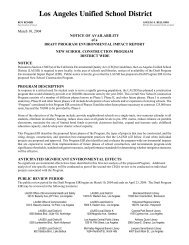Site-Specific Health and Safety Plan (HASP) - Laschools.org
Site-Specific Health and Safety Plan (HASP) - Laschools.org
Site-Specific Health and Safety Plan (HASP) - Laschools.org
Create successful ePaper yourself
Turn your PDF publications into a flip-book with our unique Google optimized e-Paper software.
LAUSD Proposed South Region High School #9 & Middle School #4<br />
6-16<br />
December 2006<br />
<strong>Site</strong> <strong>Specific</strong> <strong>Health</strong> & <strong>Safety</strong> <strong>Plan</strong> (<strong>HASP</strong>)<br />
Personnel are advised to wear sturdy work clothes, including long-sleeved shirts <strong>and</strong> heavy work<br />
gloves as necessary to protect against skin punctures <strong>and</strong> irritations.<br />
6.3.3.3 Rodents<br />
Another potential biological hazard is contracting respiratory illness from rodent droppings. In<br />
the western U.S., hantavirus is carried by the deer mouse <strong>and</strong> may be transmitted to humans by<br />
contact with its saliva, urine, <strong>and</strong> feces. People become infected when the virus is inhaled,<br />
through breaks in the skin, by ingesting contaminated food or water, or by being bitten by an<br />
infected rodent.<br />
Although the chance of getting the virus is very low, the virus is extremely dangerous <strong>and</strong> may<br />
be fatal to those who are infected. The disease begins with non-specific flu-like symptoms that<br />
include fever, muscle aches, headaches, abdominal pain, nausea, vomiting, coughing, <strong>and</strong><br />
shortness of breath. Progression of the disease leads to fluid in the lungs, heart irregularities, <strong>and</strong><br />
kidney failure. The symptoms begin between three days <strong>and</strong> six weeks after exposure to rodents,<br />
<strong>and</strong> rapidly progress to severe lung problems <strong>and</strong> respiratory failure.<br />
Personnel should be aware that infected mice may be present in semi-rural settings <strong>and</strong> vacant<br />
buildings <strong>and</strong> should avoid activities that may disturb fresh or dried rodent excretions in such<br />
areas. Personnel will use high efficiency particulate air (HEPA) equipped air-purifying<br />
respirators when working in rodent-infested areas or when entering shed of buildings containing<br />
mice infestations. Vector control authorities should be contacted upon the discovery of an active<br />
infestation.<br />
6.3.3.4 Human Biological Waste/Bloodborne Pathogen Control<br />
A shovel should be used to remove the material from the work area. Chlorine bleach/disinfectant<br />
will be used to decontaminate the shovel. If project personnel is accidently pricked by a<br />
hypodermic needle, he/she will be immediately transported to the local emergency hospital for<br />
evaluation <strong>and</strong> treatment. The SHSO will contact the PM <strong>and</strong> an accident report will be<br />
prepared.<br />
207







